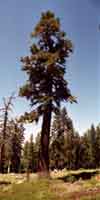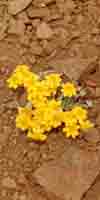


High Sierra
Backpacking
Trail Guide
Forums
Sierra
Weather
WeatherNotes Northern
Sierra Weather
Gear
Four Season
High Sierra
Backpacking Gear List
Languages
Trail Skills
Mountain
Safety
Food
Planning
Trail Arts
More
Information
Social
| HOME PAGE | GEAR PAGE | GETTING STARTED |
LAYERING | BOOTS | UPPER BODY INSULATION |
TRAIL SKILLS |
GEAR FORUM |
WEATHER | PLANNING |
High Sierra Backpacking Gear
|
On This Page |
|
|
Forum and Feedback Note the links to the Gear Forum for each type of gear. I'd like to hear what you use, how it works, and how you like it. I want your gear tips, advice, experiences, and even your gear reviews to supplement and expand this gear list. Post up your feedback in the Supplemental Topics
|
Al's Basic Upper Body |
|||
| Upper Body | Summer | Spring and Fall | Winter |
Base Layer This is our "wear all the time" Layer against our skin. |
Two 100% poly thin upper insulation layers: Thin Poly Tank Top for days. Thin Poly Long Sleeve added for bad weather and at night. Option |
Same 2 Thin Summer Poly layers used 24 hours, except during hard work. 1 or 2 upper base layers depends on daily temps. |
2 thin Poly layers Three base layers-depending on daily temps. |
Insulation Layers Insulation layers are added and subtracted depending on temp. |
Options |
Option |
REPLACE |
Shell Layer This is our outer wind and rain protection. |
Very Light weight water/wind proof shell upper. Option |
Medium Weight Shell Upper |
REPLACE Medium weight Shell with Heavy Winter Mountain Jacket |
| Notes: | Our "base layer" is our minimal layer of insulation that never comes off, without creating sweat while working. During Summer this layer may be a tank-top. During Winter it will be a layer substantial enough to handle low temperatures while hiking hard without sweating. Our base layer is a perfect balance between ambient air temperature and work-generated heat. |
||
| Upper Body Insulation Gear Forum | |||
| Lower Body | |||
| Lower Body | Summer | Spring and Fall | Winter |
Base Layers |
Option |
Add Option |
|
Insulation Layers |
Option Add Medium Poly thermal pants Night wear above zip-to-shorts, or very cold day wear. |
Add Medium Poly thermal pants (winter base layer, over poly pants, under zip-to-shorts, with fleece pants above those. Very Cold Weather 4 layer Base Layering) |
|
| Shell Layer | Lightweight wind/water proof lower shell | (Same for Spring/Fall)
Option |
Replace Light/Medium weight Shell with Heavy Winter Mountain Pants |
| Notes: | My lower body generally requires one layer less than the upper body for a given temperature range. | ||
| Member's Favorite Shirts and Pants |
Member's Favorite Down Coats |
Member's Favorite Outer Shells |
|
| Top of Page | |||
| Head | |||
| Head | Summer | Spring and Fall | Winter |
Head |
Breathable Nylon Hat, big rim 100% poly skin-tight head cover Fleece ear warmer head band |
|
Add |
| Notes: | As important for sun protection as heat retention. | ||
| Head and Face Gear Forum | |||
| Hands | |||
| Hands | Summer | Spring and Fall | Winter |
Hands |
Light weight wool gloves |
Add/Option |
Add Add |
| Notes: | My light wool gloves are missing the tips of the "pincher fingers" to perform camp tasks. | ||
| Gear for the Hands Forum | |||
| Top of Page | |||
| Boots & Feet | |||
| Boots & Feet | Summer | Spring and Fall | Winter |
Boots, Feet |
Trail Footware Light/Medium Wool Socks Camp Footware Fleece Socks Camp/Fording Shoes |
Replace
Replace |
Replace Replace Add |
| Notes: | Make sure we have our boots and feet broken in long before we hit the trail. If not, we should adjust our First Aid Kit accordingly. |
||
| Member's Favorite Backpacking Boots | Member's Favorite Gaiters | Member's Favorite Backpacking Socks | |
| Sleeping Gear | |||
| Sleeping Gear | Summer | Spring and Fall | Winter |
Sleeping Gear Tent |
2 50' lengths of parachute cord, 5 MSR Ground Hog Stakes
40° Sleeping Bag, with Killer Water Proof stuff sack Option
Closed Cell Foam Pad |
Replace |
Replace Replace Add
Replace |
| Notes: | I will only bring my lightweight 20° sleeping bag during periods of Summer when I anticipate cold Summer nights. If we bring the 20° bag and it's hot we will be bummed out. If we bring the 40° bag and it turns cold we will be bummed out. The kicker is that nighttime temperature averages can change rapidly and radically. I adjust by wearing more or less layers at night. |
||
| Sleeping Gear Forum |
Member's Favorite Backpacking Tent |
Member's Favorite Sleeping Bags |
Member's Favorite Sleeping Pads |
| Top of Page | |||
| Travel Aids | |||
| Travel | Summer | Spring and Fall | Winter |
Travel |
Balance-Rhythm-walking Stick optional. I am not impressed with two sticks, but each to their own style... |
Add Add Add (If necessary) |
Add Add Add Add Add |
| Notes: | |||
Travel Aids Forum |
|||
| Food Prep | |||
| Food Prep | Summer | Spring and Fall | Winter |
Food Prep |
One Med. Alum Pot Plastic Spoon-Fork Insulated Mug 2 Water-proof nylon food hanging bags 100' length parachute cord |
Garcia Bear Proof may be optional, depending on snow. |
Note: 5 days of fuel becomes 3 in snow.
Remove |
| Notes: | Food Storage vs. Bear Practices & Available Natural Resources Five Page Article with four Videos on prepping and packing a dense five day menu |
||
| Member's Favorite Backpacking Stoves | Member's Favorite Backpacking Cookware | Member's Favorite Bear Protection |
|
| Top of Page | |||
| Water Purification | |||
| Water | Summer | Spring and Fall | Winter |
Clean Water |
Pur Hiker
Hand Bottle
|
|
Remove
Note: 5 days of fuel becomes 3 in snow.
Replace |
| Notes: | Best Backpacking Water Filter Options, with a close look at Filtration and Purification Basics |
||
| Miscellaneous | |||
| Miscellaneous | Summer | Spring and Fall | Winter |
Miscellaneous |
Sunglasses Optional
First Aid: See below
Two Djeep Lighters
Waterproof matches
Fire starter: Dried snag cubes, wax, old MRE fuel tab, or Magnesium sparking block
Flash light
Shit Trowel Get Your Shit Shovel Together: Skills Toilet Paper
Camera/Batteries/Charger
Ass Pack, pen, pencil
Swiss Army Knife
Thermometer
Compass |
|
|
| Notes: | |||
| Top of Page | |||
| First Aid | |||
| First Aid | All Seasons | ||
First Aid Your first aid kit should be custom tailored for your own personal physical needs. The number of each type of drug and bandage depends on the length of the trip, how sensitive your feet are to blistering, previous injuries and objective dangers. I've seen folks try to break themselves every way possible... |
DRUGS
Aspirin
Ibuprofen
Codeine for me
Morphine |
Knee brace
large Telfa Gauze pads: 3 in x 8 in
Large self-adhesive bandages: 4 in x 3 in
Medium Self-adhesive bandages: 4 in x 2 in
10 band aids |
3M steri-strips, 1/4 x 4 in
Band Aid Butterfly closures, medium
Triple antibiotic cream
Domeboro: Burn Dressing Hypergel wound dressing
Sterile wipes |
| Notes: | I generally use up and give away substantial first aid gear to blistered, rashed, sprained and strained backpackers every season of every year. I don't like to give away my ace bandages (due to my previous injuries) so I generally "unwind" or cut the injured backpacker's clothing to make support bandages and wraps. You should see their faces when I pull out the knife... haha... The key is to anticipate your previous injuries acting up, anticipate a sprained ankle, and assume that blisters will appear. Our first aid motto: |
||
|
Feel the Wisdom |
|||
| Personal | |||
| Personal | Summer | Spring and Fall | Winter |
Personal Care |
Moisturizer Baby Oil Mini-toothpaste & Brush Comb Lip Balm Suntan Lotion Option: Square Piece of backpacking towel Bandana Nature/tree guide, doubles as journal Balls: Don't freak out. Ibuprofen and Codeine |
Same |
Same |
| Notes: | We will pack our liquids in small plastic travel bottles, and we will send ourselves resupplies of all consumables. In addition we will send small bottles of shampoo and small bars of soap to the resupply spots that have showers. |
||
| Top of Page | |||
| My Backpack(s) | |||
| Pack | Summer | Spring and Fall | Winter |
Backpack |
5 lb external frame pack, with 2 bungee cords, two fabric straps, one webbing strap. |
Option: 5 lb internal frame pack |
Option: 5 lb internal frame pack |
| Notes: | I bring an old-school Kelty day pack for scrambling and local peaks. | ||
| Pack Forum | Member's Favorite Internal Frame Packs |
Member's Favorite External Frame Packs |
Member's Favorite Ultralight Packs |
| Electrics | |||
| Electrics | All Seasons | ||
Camera(s) |
Cannon PowerShot 2000, AA. Go Pro, cell-phone battery. REVIEW |
||
Flashlight |
Princeton Tec Headlamp, AAA. Decades of various Petzel Headlamps, AA Started with Maglite, AA. |
||
| Charger | Tried Solio with various degrees of success. REVIEW Good Report: Andrew and Tanja like their Suntastic 12 x 8. |
||
| GPS | No GPS ever taken or used on any backpacking trip ever. | ||
| Batteries | Rechargeable. Generally AA. | ||
| Notes: | We must have a charging and/or battery resupply plan that keeps our camera charged at all times. | ||
| Electrics Forum | |||
| Top of Page | |||
| This Gear List | ||
| This kit composes my basic HOPP setup: The Harness of Pain and Pleasure! |
SPRING-FALL This kit has proved adequate for all High Sierra early Spring and late Fall conditions I've encountered. |
WINTER This kit has proved adequate at 10° with a 50 mph standing wind, properly set, mid-Winter |
Disclaimer Backpacking in the High Sierra presents serious potential dangers that may exceed the scope of gear, experience, and fitness. |
||
Last page: Navigation Next page: Bear Tech
High Sierra Backpacking Gear List |
Our
Goal The object of the above gear list is to provide us with the information so that we can select the basic level and range of personal insulation necessary for us to work hard during the day and rest warmly during night. Variable Playing Field Gear is blind Your Vision I don't like either long end of this bell curve of brutality. I'm hunting for "just right." Internal Vision Inform Thyself |
Backpacker ForumsHave a great or terrible experience backpacking in the Sierra Nevada to relate? Post it on The Forums are broken down to cover High Sierra Backpacking Trails and Topics:
Anyone can post up comments. Members can post up images, maps, and videos in their own posts in the forums. Have a great or terrible Sierra Nevada gear experience to relate? Let it Rip HERE: |
Trailhead
Contact
Alex Wierbinski

Backpacking Lake Tahoe to Mount Whitney
Your guide to the High Sierra Crest, including the Tahoe to Yosemite, Pacific Crest, and John Muir Trails
